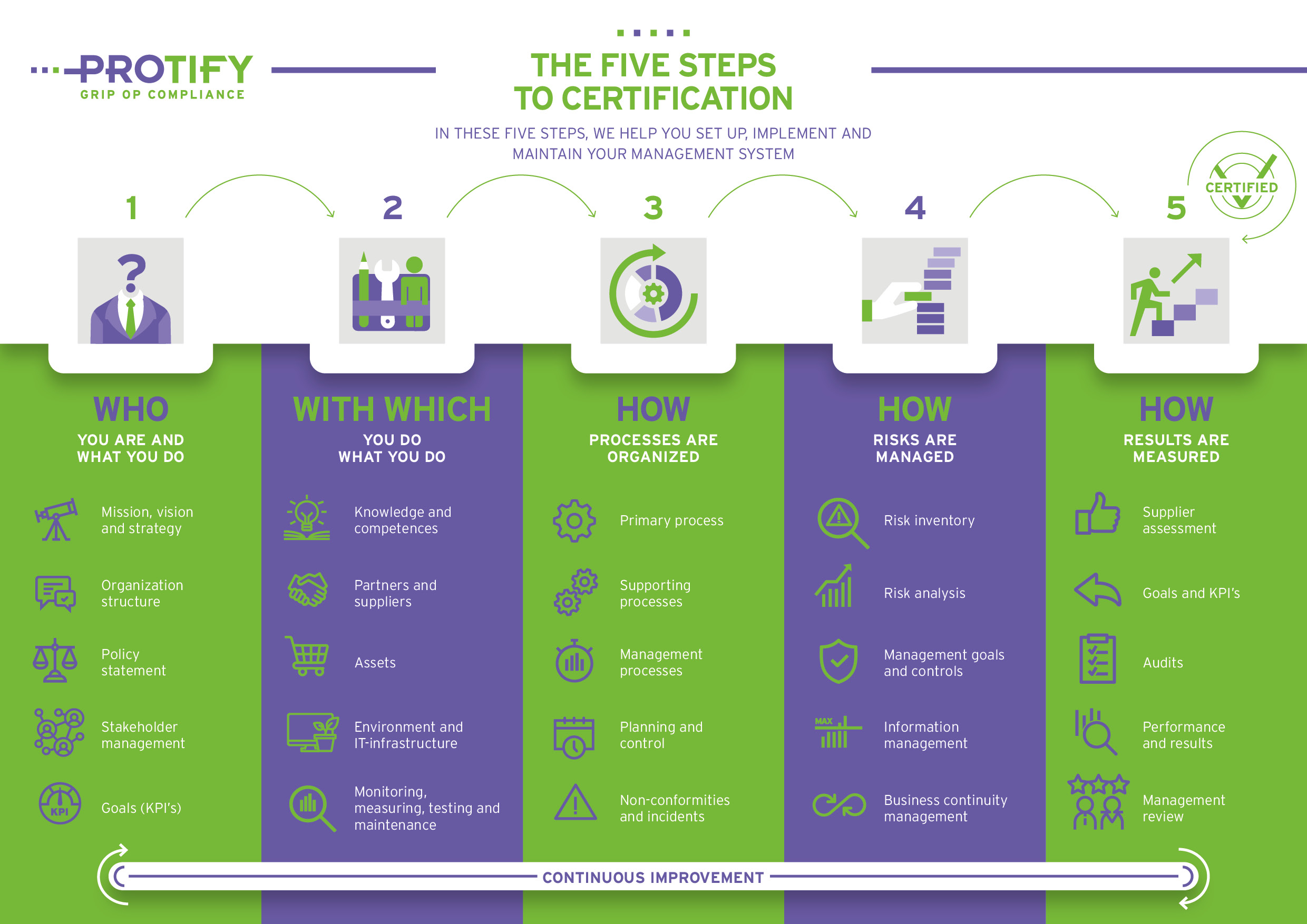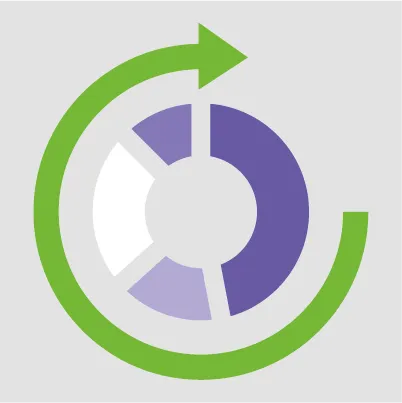Services for your organisation
Design and implementation
Step-by-step towards certification
Protify guides companies from intake to achieving a certificate or assurance report and supports them in complying with (internal) laws and regulations. From setting up and implementing a management system or controls framework to organising and maintaining processes within the organisation. We do this on a project basis, through Managed Services and the Proactive Compliance Tool (PCT).
Our combination of solid project management and the Proactive Compliance Tool translates seemingly complex compliance into a manageable and efficient process. Thanks to our pragmatic approach based on clear steps, we turn compliance into a transparent, insightful, and continuously improving process.

We support the development of policies and required controls to ensure an organisation is ready for certification. We do this for standards such as ISO 27001, ISO 27701, EN 50518 and ISO 22301. Due to a lack of time and knowledge, many organisations fail to meet the obligations set by, for example, governments or insurers. What can we do? Protify’s experienced consultants help companies define business processes and identify both existing and missing (required) documentation. We then provide advice tailored specifically to your organisation. Our consultants also assist with the implementation of required documentation and provide guidance throughout the certification process. Thanks to our proven approach, companies can meet the set requirements in a short time.
The five steps towards certification
An Integrated Management System (IMS) is a structure that supports various standards and assessment guidelines that converge within the management system. An online software tool helps you identify, monitor and control compliance risks and operational activities. It offers a consistent approach to managing and streamlining processes related to standards, legislation, or internal procedures relevant to the organisation. We understand that maintaining your policy documentation, management information and certifications is often seen as paperwork. That’s why we want to make it easier and more accessible for your organisation. We have therefore chosen the following five steps for setting up and implementing a management system or controls framework aimed at certification and continuous improvement:

The steps explained

Step 1: Leadership and strategy
Who you are and what you do
Leadership and strategy focus on the PLAN phase of the Plan Do Check Act (PDCA) cycle. In this step, you determine what services your organisation provides, which objectives you aim to achieve in the coming year, who will be involved, and how you will steer towards those goals. This gives clarity on where your organisation’s focus lies.
- Scope of your certification: which departments and processes do you want and need to certify?
- Who are you as an organisation and what does this include?
- What does your organisation do? What services or products do you provide?
- Context
- Mission, vision, strategy
- Policy
- Organisational and communication structure
- Relevant laws and regulations
- Stakeholder management
- Objectives and KPIs

Step 2: People and resources
What you use to do what you do
People and resources focus on what and who you need to run your operations. This applies to both providing services and producing products within your organisation. In this step, we specifically look at people, partners and suppliers, and asset management.
- Knowledge, competences, professional skills and awareness
- Partners and suppliers
- Required company assets
- Working environment and ICT infrastructure
- Monitoring, measuring, testing and maintenance

Step 3: Process management
How processes are structured
The third step is process management. It covers how services are delivered and how processes operate within your organisation.
- Primary business processes
- Supporting processes and procedures
- Control processes
- Planning and monitoring of activities
- Incident and complaint procedures

Step 4: Risk and information management
How risks are controlled…
Risk and information management involves identifying, analysing, assessing and evaluating your organisation’s risks, and defining any necessary control measures. It also covers how your organisation’s documented information is made available and whether it is adequately secured.
- Risk identification
- Risk analysis
- Defining and implementing control measures
- Physical and information security
- Business continuity plans
… and how information is managed
Information management focuses on how information is handled and how data is classified. How is documented information managed? What information falls within the scope of the management system, how is it documented, and how are the related processes structured and recorded?

Step 5: Performance and results
How results are measured
This phase involves monitoring, analysing, measuring, and evaluating various components of your management system. You do this through internal audits, management reviews, supplier evaluations, and by reflecting on your organisation’s objectives. The outcomes from this phase are recorded and can be used as input for your organisation’s continuous improvement. So, don’t view this as the final step, but as an integral part of the process where your management information is continuously maintained, evaluated and improved.
- Supplier evaluations
- Reflection on objectives and KPIs
- Audits
- Evaluation of business performance
- Management reviews
Want to start implementing a management system or framework?
Are you excited about our approach and would you like to get started with implementing a management system, compliance or a controls framework? Then get in touch with us!
Why choose Protify
Our consultants have in-depth knowledge of standards and experience implementing them across a wide range of organisations. They know exactly what the standard requires and how to translate it into practical measures on the work floor. This helps prevent misinterpretations or unnecessary measures.
A consultancy partner provides structure, maintains momentum, and prevents you from wasting time reinventing the wheel. By guiding the process efficiently and using a phased approach, the overall lead time is significantly reduced.
An external consultant brings an objective view of the organisation. As a result, risks and bottlenecks are identified more quickly.
We ensure the management system fits your organisational culture and processes. We support practical decision-making and create internal support by actively involving employees in the implementation — essential for a system that works not only on paper but also in daily practice.
Get started now
By choosing support for the setup and implementation of a certification project, you increase the chances of an efficient and successful certification, with a system that not only meets the standard but also works in practice.
Contact us for a no-obligation introductory meeting.
